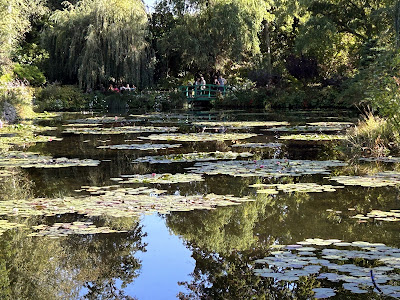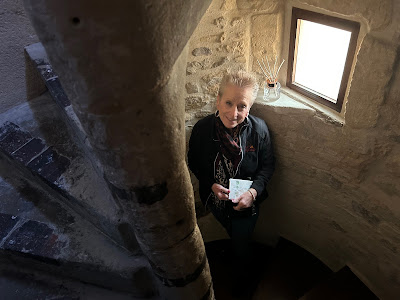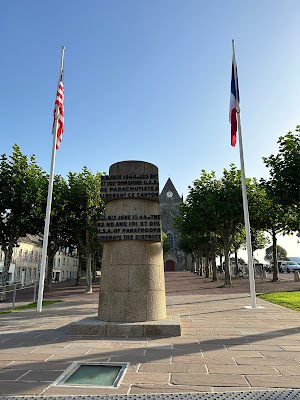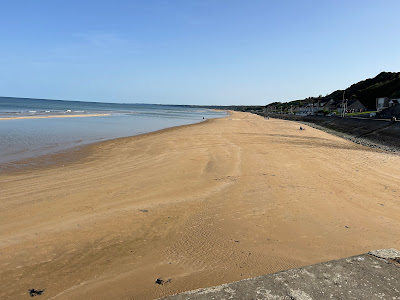This is an overview of the rest of our stay in France and heading back to London. Our last day in Bayeux we were up early for our second tour, Mont Saint Michel. It was about a 70 mile drive through the beautiful Normandy countryside.
Yes, that is Nanc eating French pastries for breakfast.
This was not our first glimpse of Mont Saint Michel, but the first picture I was able to get. You can see it off in the distance as you drive down to the coastal flats.
Mont Saint Michel is built on a granite island about a half mile off shore. It was established as a monastery in 708 by Bishop Aubert after a vision of Archangel Michel appeared to him three times. In 1023 Benedict monks settled here and started construction of the Romanesque abbey. It became a major center of culture in the Middle Ages that welcomed pilgrims.
In the 11th and 12th century the walls were added to protect the abbey from attack. After a fire in the 12th century the abbey was reconstructed in the new Gothic style and the ramparts were strengthened.
Our group inside the ramparts. After the abbey withstood an attack by England in 1433, Louis XI turned it into a prison.
The tides here vary greatly. In 1879 a causeway was built that was only usable during low tide. In 2006 the causeway was replaced by a bridge. Once every 18 years there is a super tide that even covers the new bridge. This picture was the last super tide on March 21, 2015. This is were we are standing in the above picture.
An aerial view of the 1979 super tide. That was also the year Mont Saint Michel became a UNESCO World Heritage Site.
Inside the walls is a little village with many shops, restaurants and hotels. There are a small number of people who live here including a few monks and nuns.
This particular restaurant is known for its famous truffle omelettes created by Anne Boutiaut Poulard in the late 1800's. At 45 euros, about $50, we passed. The other restaurants had omelettes at a much lesser price.
Once inside the walls the street is lined with many chances to shop. It is a steady climb from here up to the abbey.. The climb seems to deter many people, so the higher we walked it became less crowded .
Once you are passed the shops you see the church and spiral and realize you still have a long climb ahead.
At the top of the walkway the steps started. I don't know how many there are here, but I got nearly 18,000 steps that day. As you can see the crowd has thinned out a lot at this point.
The view of the bridge from the top. In the past you could drive across the causeway and park near the abbey. The problem was the causeway blocked the flow of water and silt built up so the island would not get completely surrounded by water even at high tide. When the bridge was built they also built a dam on the river to control the flow of water and wash out the silt. Now at high tide water surrounds the abbey.
Looking out the other side to Saint Malo Bay. You can see how far out the water is at low tide. The island in the distance is Tombelaine. It is accessible by foot at low tide, but only with a guide as quicksand is a real thing here. It was occupied in the past by hermit monks and then by the British.
The cloister, built in the 13th century in the Gothic style, was three levels. This is the garden suspended between the sky and sea.
This is the scriptorium where the monks copied manuscripts including bibles and scientific works. Only 200 of the estimated 800 done survived the fire. They are stored in the Scriptorial Museum in Avranches.
This giant wheel was used to lift material used during construction. A man would get inside the wheel and walk to turn it to pull a sled-like carrier up a track.
Looking down the track. It sure made the job of lifting material a lot easier than getting it up all those steps.
Mont Saint Michel is one of those places we have always wanted to see. It did not disappoint. Being in a small group and having a guide like Caroline made it much better than doing it on our own.
The next morning we were up early to take the train to Paris. No reservations were needed because there is a train almost every hour.
The trains are very modern and comfortable. It took about 3 hours to go the 160 miles to Paris.
In Paris we stayed at Residence du Pre located near Gare du Nord the train station we would be using to get back to London. We were on the 6th floor so we thought we were in the penthouse! Not so. The elevator was not big enough for two people plus bags and only went to the 5th floor. That said, the room was fine except there was no AC and it was in the 80's both days we were there.
We were within walking distance of the Basilic Coeur de Montmartre. As you can see, it is a major tourist stop.
From the top there is a great view of the city. That said I do believe we may be the only people to visit Paris and not see the Eiffel Tower. We have been here before so it was not on our must see list.
The Montmartre neighborhood around the church is very neat with many restaurants and artist. This guy playing the accordion is well known. I saw his picture on websites I used in planning our trip.
A square filled with artists. You could buy works of art or get your portrait done.
Outdoor dining is wonderful. In France eating is more than just gobbling down a meal. It is an event that is meant to be enjoyed. Of course, the people watching is a major part of the experience.
This is a display of artwork along one of the streets.
Our goal for our two day stay in Paris was to travel to Giverny. It was about 45 miles from where we were staying. Once again it was an easy train ride there and back.
Giverny is the home and gardens of French artist Claude Monet (1840-1926). We had been very happy with our Viator guides in Normandy so we scheduled a tour with them in Giverny.
Monet is considered the founder of the impressionist movement which lead to modern art. Much of his work was done en plein-air, leaving the four walls and painting outdoors. This allowed the artist to use the changing light and how it affected the colors.
Like many artists of the time Monet struggled financially until he and other impressionist artists started showing their work at the Exhibition of the Impressionist in Paris in April 1874. His work was one of the few that became popular and he became very wealthy. He used is wealth to buy this house (a former cider mill) in Giverny.
Walking through the home is like being in a museum, though Monet's paintings here are not originals.
More of his work.
Alice, Monet's second wife, and Claude. Their relationship was a long struggle raising his two children and her six. They all lived in the house in Giverny.
Once he became wealthy he began collecting art. He had great interest in Japanese art that had developed during a time when Japan was isolated from the rest of the world.
My favorite model at Giverny.
The gardens. Monet bought more land around his home and created the gardens and pond that are in many of his paintings.
During his time there he had seven gardeners. Today the Foundation Claude Monet has 12 gardeners including interns who train here.
Monet's plan was to create a living plein-air outdoor studio. He had a palette on wheels to easily move around the grounds. The bamboo was part of the Japanese theme. He diverted water from the stream to make a pond with the waterlilies.
The Japanese bridge is in many of his painting.
A boat often appears in his work. He had a boat on the pond that was a small studio, so he could move around to get different perspectives.
My pictures from different perspectives as we walked around the pond. This one includes the bridge.
From the other side of the pond. The woman could have been a model for one of Monet's paintings.
Our guide told us we were fortunate to see the waterlilies in bloom as that morning it was cool and they were not open.
This is one of Monet's many waterlily paintings. He did nearly 250. As he grew older his eyes became worse and his impression of the lilies changed. After the Armistice on November 11,1918 he gifted a series of these paintings to France as a symbol of peace. They were installed in the Orangerie Museum. Here is a link to those pictures. Unfortunately, we did not have the time to see them in person.
Our last evening in Paris we found a neat little 10 table restaurant, Hugo. We overdid it with a bottle of French wine, escargot, wonderful bay scallops, ending with an espresso and dessert. Our meal was fantastic.
To return to London for our flight home we took the Eurostar fast train. It went 180 mph, taking only 2 hours 15 minutes from the middle of Paris through the Chunnel (Channel Tunnel) to the middle of London. When booking Eurostar check the times and prices carefully. If we had left at 11AM it would have cost 170 pounds. By leaving at noon it was 120.
We took a cab from St Pancras Station to our hotel above the Pride of Paddington Pub. It was across the street from Paddington Station where we could get the Elizabeth Line to Heathrow. Across the street from the hotel where we stayed was the Marten Bass Real Time Clock. Here is a Youtube video showing how it works. Poor guy works 24/7/365.
On our way to the station we took a short break at The Wild Table of Love. It was a fitting end to our time in Europe before heading back to Pittsburgh.
We had a great time on the Norwegian Dawn getting to spend time with our friends and checking out the sites. We were so glad we extended our trip to also visit France.We loved the smaller tours as they were more in depth and much more enjoyable than the large excursions we took from the ship.





































































































